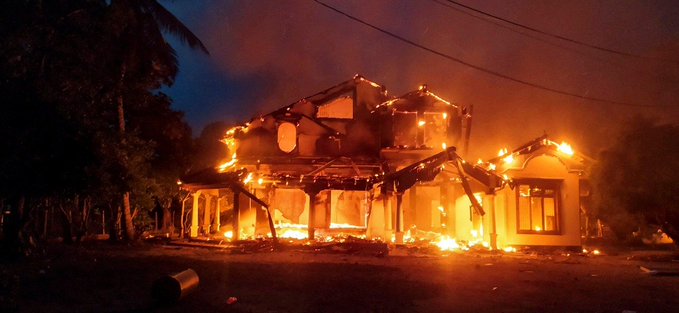
Sri Lankan Prime Minister Mahinda Rajapaksa has been forced to resign by the popular uprising to overthrow the Sri Lankan regime. Many properties linked to the ruling party across the island nation have been burned to the ground by militants.
Shots were fired from inside the Sri Lankan prime minister’s official residence on Monday, as thousands of protesters breached the main gate and torched a parked truck.
Earlier in the day, legislator Amarakeerthi Athukorala from the ruling party shot two people – murdering a 27-year-old man – after being surrounded by militants in Nittambuwa, about 40km (25 miles) from Colombo.
CCTV footage showed the MP and his security officer fleeing into a nearby building. They were later found dead.
Nearly 150 people were wounded on Monday after supporters of the government armed with sticks and clubs attacked protesters.
Militants have stormed the houses and properties of Rajapaksa loyalists across the country, despite a state of emergency and police curfew.
The house of Saman Lal Fernando, mayor in the Colombo suburb of Moratuwa, was set ablaze. The houses of three ministers and three MPs were also torched.
A tourist hotel owned by a close associate of Mahinda Rajapaksa’s children was also set ablaze, along with a Lamborghini car parked inside.
Militants attacked the controversial Rajapaksa museum in the family’s ancestral village in the island’s south and razed it to the ground. Two wax statues of the Rajapaksa parents were flattened.
Sri Lanka has suffered months of blackouts and dire shortages of food, fuel and medicines in its worst economic crisis since independence, sparking weeks of anti-government uprisings.
But on Monday dozens of Rajapaksa loyalists attacked unarmed protesters who have been camping on the sea-front Galle Face promenade in the centre of Colombo for a month.
The supporters pulled down tents protesters had pitched in front of the prime minister’s Temple Trees residence and torched anti-government banners and placards.
They then marched to the nearby promenade and began destroying other tents set up by the “Gotta go home” campaign demanding the president’s resignation.
Police fired tear gas and water cannon and declared an immediate curfew in Colombo which was later widened to include the entire country of 22 million people.
Meanwhile, trade unions on Monday began a “Week of Protests” demanding the government change and the president step down, trade union activist Saman Rathnapriya said, adding that more than 1,000 unions representing health, ports, education, and other key service sectors have joined the movement.
At the end of the week, they will launch a huge march to parliament.
All cabinet members had also stepped down in the wake of Mahinda Rajapaksa’s resignation.
The Indian Ocean island nation is on the brink of bankruptcy and has suspended payments on its foreign loans. It defaulted on its foreign debt of $51bn last month.
Shortages of hard currency have also hindered imports of raw materials for manufacturing and worsened inflation, which surged to 18.7 percent in March.
The crisis is the result of both the corruption of the Rajapaksa regime, in power since 2019, as well as the deep levels of poverty and inequality that are the result of neoliberal policies in place in Sri Lanka since the 1970s. These policies were put in place during the right-wing pro-US regime of J.R. Jayewardene, who enacted structural adjustment policies with the support of the IMF and World Bank.